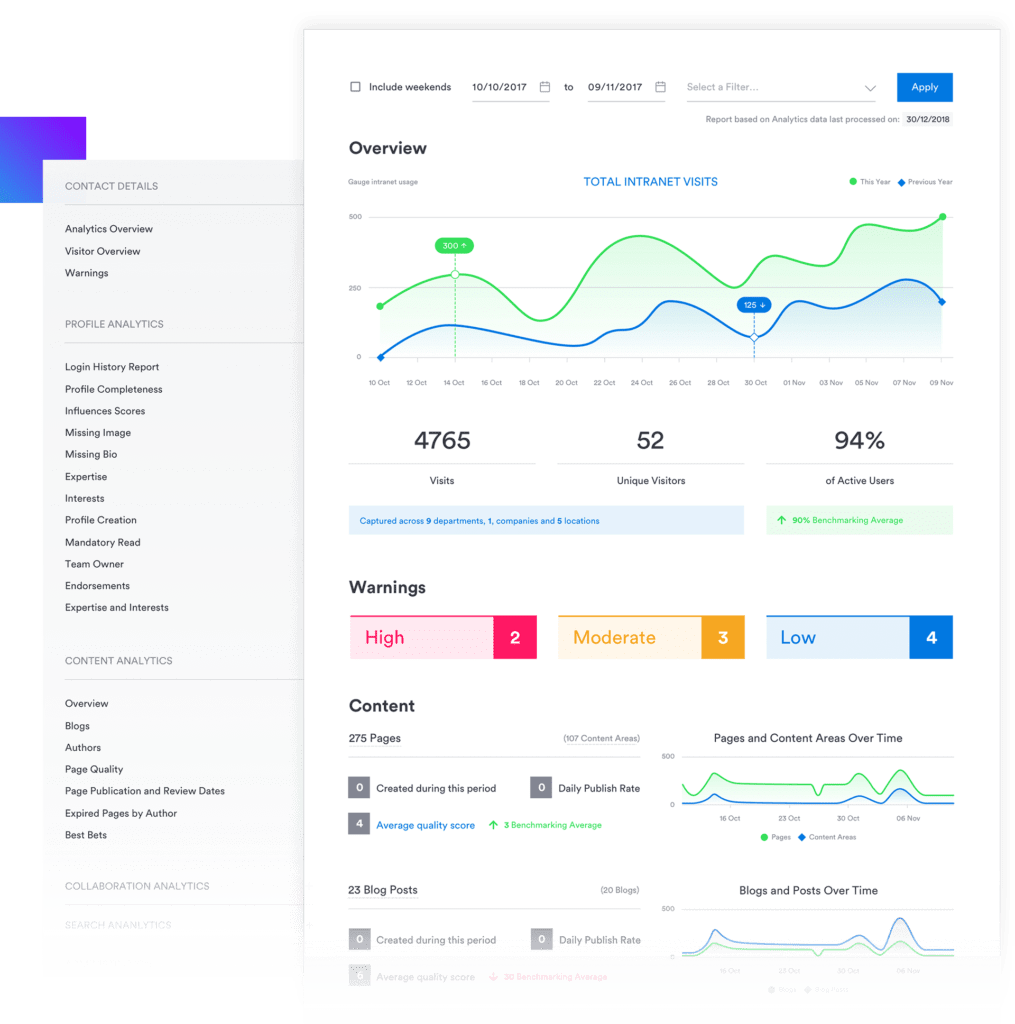3 great ways to measure the effectiveness of your internal comms
You can’t fully understand the impact of your marketing unless you fully understand the results of your efforts. If you are genuinely concerned about the reach of your content labors, it’s time to start measuring your internal communications.
Internal communications have a direct impact on the bottom line of any organization. Between increased retention rates and amplified employee performance, the benefits are undeniable. However, because of the lack of quantitative and qualitative indicators, communicators can struggle to prove this business value to management.
For most, compiling, analyzing and stressing over statistics seems like the only way to go. But in the grand scheme of things, stats only prove so much, especially when it comes to IC. At times, they may even tell a different account of what’s really happening inside your organization.
Impact measurement is a struggle in even the best communication departments. A study by Gallagher Communication disappointedly announced that the number of internal communicators not measuring the impact of their internal comms stands at 12% this year, an increase from 6% in 2017.
Even those organizations that do partake in measurements may not be entirely satisfied with their protocols (16%).
So, what is the best way to determine measurable business impact?
While built-in analytics tools are efficient, one of the best and most complete way to measure the impact of your IC is through the use of your company intranet. With a number of features and collaboration tools catered to your workforce dynamics, your intranet can be used to create and track measurable results — here’s how.
Why measure IC at all?
Not knowing how effective your internal communications are can hinder your overall productivity and, by default, your organizational success.
Statistics from Ragan indicate that 56% of companies don’t get useful user data from their intranet. Meaning that more than half of companies have no idea whether or not their IC is positively or negatively influencing their employees.
These measurements cannot go unchecked. A poor communications strategy can have repercussions such as lowered efficiency, low employee engagement, a high turnover rate and a blow to your bottom-line.
Tracking your IC efforts can benefit your org in ways that are more critical than they seem. Improved time management, better budget administration and steady reports on what actually works for your IC are a just a few of the rewards that come with measurement.
Your findings will show you what methods best resonate with your employees so you can get your messages across the right way. The next step is deciding which measurement protocols you should be putting in place.
Analytics
Before we can effectively analyze any information, we need to gather the data that has the greatest effect on your internal comms.
While getting these metrics is not the only way to determine the impact of your IC, it is a powerful way to generate a report that can be combined with all the other efforts you have applied toward measuring your IC.
The best place to start collecting from is your intranet. To collect data about user engagement on your intranet, you should determine the answers to some of the following questions:
- How many employees use the intranet?
- How regularly?
- Are there particular demographics that use the intranet more others? Less?
- When are they using it? Are there particular ‘peak times’ for usage?
- How are they accessing it? (from their mobile device, work computers, etc.)
Analytic tools, such as our Interact Analytics feature, answer these questions by offering insights that include page visit statistics, user influence scores, and active user figures.

These can also be integrated with third-party tools such as Google Analytics, allowing you to monitor both your website and your intranet through the same interface.
Set key performance indicators (KPIs) to measure which of your internal communications efforts are hitting the mark. These KPIs should measure everything from email open rates to page click-throughs.
When measured together, these values will paint a clear picture of how your employees are reacting to your IC. For example, if a posted video has viewers dropping off before the end, that can be an indication that future videos should be shorter. KPIs allow you to subtly or even dramatically adjust your comms behavior to attain the best result.
Don’t forget to track your KPIs regularly. Review performance on a weekly, monthly, quarterly and yearly basis. Keeping up to date will ensure you accurately determine where your failures and successes lie.
Pulse surveys
In addition to the quantitative measures that are determined through analytics, qualitative communication methods should also be undertaken.
If you want to know which communication methods get your message across the first time, then why not go straight to the source? Your employees are your direct line to what works best for your internal communications.
They know what methods work, what needs improvement and what needs to be discontinued.
Surveys and forums via your company intranet are an excellent way to determine where the issues lie in your communications strategy, as well as provide insight as you work your way toward a solution.
However, incorporating this two-way communication method must be done right, or you’ll run the risk of annoying and distracting your staff. Consider implementing pulse surveys.
Pulse surveys give you frequent, timely feedback through a form ranging from one to ten questions. A vast improvement from the longwinded and outdated polls of the past, the key here is to keep them short, sweet and frequent.
This format of frequent short questions are customized for and better suited to today’s workforce. Keeping the length low and the response scales limited will ensure the data received is not deluded by the large sample size of your employees and their individualized needs.
This approach measurement can be coupled with the quantitative data to get an even more precise idea of what your employees are looking for and respond best to in your IC.
Track social activity
It is not only important to measure how many employees interact with your internal communications, but also how engaged and interested they are in your content.
Keeping an eye on content sharing between staff, how active they may be through forums or other social tools can be telling of how effective your methods of encouraging internal communication are.
Bad numbers may point to a more significant problem within the workforce — usually disengaged and disconnected staff.
Metrics tend to differ between social tools. However, by measuring via the company intranet, you can accurately gauge employee engagement through any of the integrated communication channels available.
When your employees are engaged, sharing and responding to company posts increases, and an open atmosphere of communication is leveled — something that will be reflected in your IC analysis.
A lack of engagement usually shows itself through poor post views, lack of commitment in forums or worse, negative comments on company posts.
Luckily, knowing where your IC falters, enables you to take action. Do not be afraid to jumpstart the conversation, create hobby or interests forums — anything to keep the conversation flowing.
Viewing social trends and behaviors in your staff via the intranet can help create measurable results that can then be placed against your business objectives.
Conclusion
Up your game now and start prioritizing your IC impact. Compiling the appropriate metrics and statistics can go a long way in creating communications tailored to your business goals and staff needs.
Regardless of where your organization stands now, tracking and analyzing performance can help you create IC content that your employees will love now, and in the long-term.

